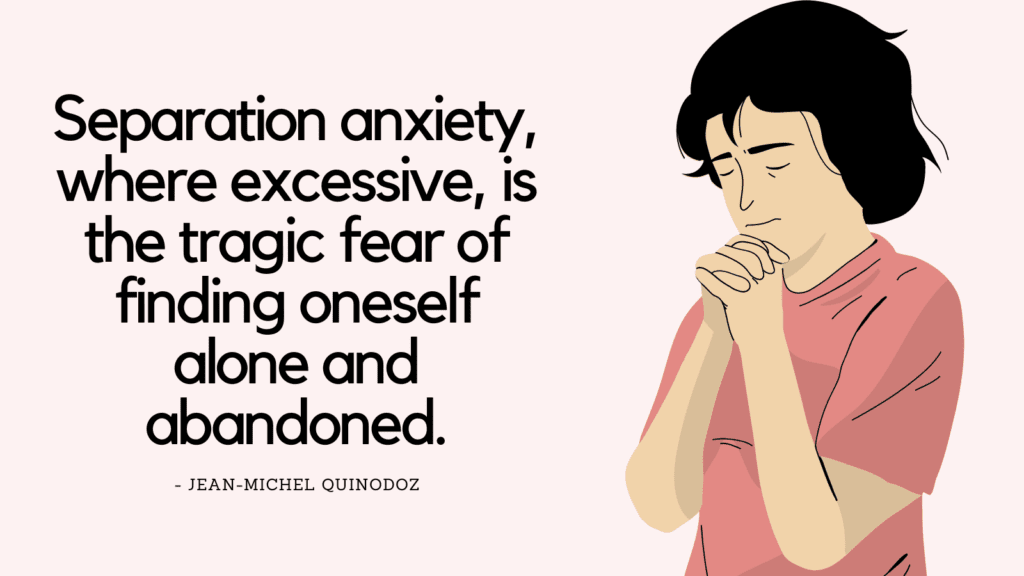This post contains some of the best separation anxiety quotes.
What Is Separation Anxiety?
Separation anxiety is a excessive fear of losing, or being away from a person or attachment figure.
The diagnostic and statistical manual of mental disorders, fifth edition, text revision (DSM-5-TR) defines agoraphobia as:
“A. Developmentally inappropriate and excessive fear or anxiety concerning separation from those to whom the individual is attached, as evidenced by at least three of the following:
- Recurrent excessive distress when anticipating or experiencing separation from home or from major attachment figures.
- Persistent and excessive worry about losing major attachment figures or about possible harm to them, such as illness, injury, disasters, or death.
- Persistent and excessive worry about experiencing an untoward event (e.g., getting lost, being kidnapped, having an accident, becoming ill) that causes separation from a major attachment figure.
- Persistent reluctance or refusal to go out, away from home, to school, to work, or elsewhere because of fear of separation.
- Persistent and excessive fear of or reluctance about being alone or without major attachment figures at home or in other settings.
- Persistent reluctance or refusal to sleep away from home or to go to sleep without being near a major attachment figure.
- Repeated nightmares involving the theme of separation. 8. Repeated complaints of physical symptoms (e.g., headaches, stomachaches, nausea, vomiting) when separation from major attachment figures occurs or is anticipated.
B. The fear, anxiety, or avoidance is persistent, lasting at least 4 weeks in children and adolescents and typically 6 months or more in adults.
C. The disturbance causes clinically significant distress or impairment in social, academic, occupational, or other important areas of functioning.
D. The disturbance is not better explained by another mental disorder, such as refusing to leave home because of excessive resistance to change in autism spectrum disorder; delusions or hallucinations concerning separation in psychotic disorders; refusal to go outside without a trusted companion in agoraphobia; worries about ill health or other harm befalling significant others in generalized anxiety disorder; or concerns about having an illness in illness anxiety disorder.”
Related: Anxious Preoccupied Attachment Style (What Is It & How To Overcome It?)
Separation Anxiety Quotes
1. “Separation anxiety is a universal phenomenon; indeed, it is such an intimate and familiar emotion that we almost have to make a special effort to realize that it is a concern which accompanies every instant of our everyday lives.” – Jean-Michel Quinodoz
2. “Separation anxiety, where excessive, is the tragic fear of finding oneself alone and abandoned.” – Jean-Michel Quinodoz
3. “Conversely, when tamed, separation anxiety becomes a vivifying force: the taming of solitude is a matter not of eliminating anxiety but of learning to confront it and to use it in order to place it in the service of life.” – Jean-Michel Quinodoz
4. “Separation anxiety corresponds to an individual’s painful sense of fear when an affective relationship with an important person in his circle is threatened with interruption or is actually interrupted. ” – Jean-Michel Quinodoz
Related: 10 Steps To End Fearful Avoidant Chase
5. “Separation anxiety is usually expressed in affective reactions in which we experience—and can describe—our feelings in relation to the person from whom we feel separated: for instance, the feeling of being abandoned and alone, sad or angry, frustrated or desperate.” – Jean-Michel Quinodoz
6. “Can miles truly separate you from friends? If you want to be with someone you love, aren’t you already there?” – Richard Bach
7. “A child can be threatened that he will be sent away, or that some alarming figure will come to take him away, or that his mother will go away and leave him.” – John Bowlby
8. “Newsons write: ‘Most of these children’s separation fears are reality-based, in that they or their mothers have been hospitalized or some other separation has already taken place.’ Nevertheless, there were some children who had had such an experience without apparently having been left prone to separation anxiety, and other children who were prone to such fears without having had such an experience.” – John Bowlby
9. “Separation anxiety results from a young child’s believing when his mother disappears that he has eaten her up or otherwise destroyed her, and that in consequence he has lost her forever. That belief, it is held, arises from the ambivalent feelings a child has for his mother, an ambivalence made inevitable by the existence within him of a death instinct.” – John Bowlby
What’s Next? How To Fix Anxious Attachment Style In 5 Steps
10. “We are living in the “age of anxiety” (Spielberger & Rickman, 1990). Indeed, anxiety disorders are the most common mental health problems affecting children and adolescents. Separation anxiety is the most common of these disorders (5–10%), with as many as 41% of youngsters reporting issues of separation anxiety (Costello & Angold, 1995). Yet a paucity of specific treatment programs is available to help these youngsters and their families.” – Andrew R. Eisen, Charles E. Schaefer
11. “The reasons for separation anxiety can range from a diagnosed anxiety disorder, to having turmoil at home, to being bullied in school, to having a learning disability.” – Diane Peters Mayer
12. “During childhood development, children between the ages of eighteen and twenty-four months often have periods of separation anxiety, too. When your child was a toddler, she may have cried and clung to you if you were leaving her with a babysitter or in day care. Although difficult to cope with, separation anxiety is considered normal at certain childhood developmental stages.” – Diane Peters Mayer
13. “Children in kindergarten have to meet the expectations of adults they don’t know and try to make friends with other students who are strangers. They are also being evaluated, graded, and judged in comparison to their peers, and that can be intimidating. These new experiences have to be handled without the safety of parents and home. No wonder children have separation anxiety.” – Diane Peters Mayer
14. “School refusal is not a diagnosable condition like separation anxiety disorder, which is a formal mental condition. School refusal only refers to the behavior of the child, but it is considered a serious emotional problem.” – Diane Peters Mayer
15. “If your child’s separation anxiety symptoms persist beyond the normal developmental stage or increase in severity, he may be developing separation anxiety disorder (SAD), which is a major reason for school refusal.” – Diane Peters Mayer
16. “An important characteristic of both school refusal and separation anxiety disorder is that anxiety and reluctance to go to school will increase if the child is allowed to stay home. The more a child is able to avoid school, the more difficult it will be to return to school. When a child is able to avoid the anxious situation, anxiety lessens, thereby reinforcing that staying home feels better.” – Diane Peters Mayer
17. “Whether your child exhibits school refusal or separation anxiety disorder, treatment is crucial to prevent negative psychological, social, and academic consequences to your child, yourself, and your family. The short-term impact on your child includes a high degree of stress and anxiety, poor academic performance, and isolation from peers. Turmoil, tension, and conflict will likely be high for other family members.” – Diane Peters Mayer

References
- Portions of this article were adapted from the book Diagnostic and Statistical Manual of Mental Disorders, Fifth Edition, Text Revision (DSM-5-TR), © 2021 by the American Psychiatric Association. All rights reserved.
- Portions of this article were adapted from the book The Taming of Solitude, © 1991 by Jean-Michel Quinodoz. All rights reserved.
- Portions of this article were adapted from the book Attachment and Loss, © 1973 by John Bowlby. All rights reserved.



